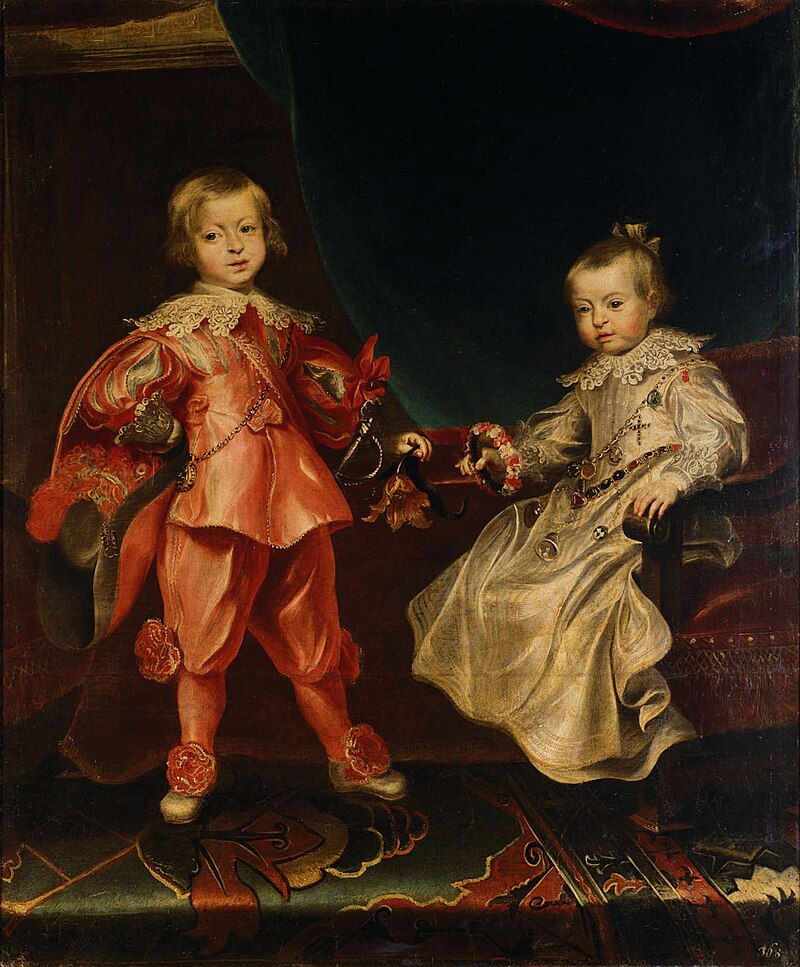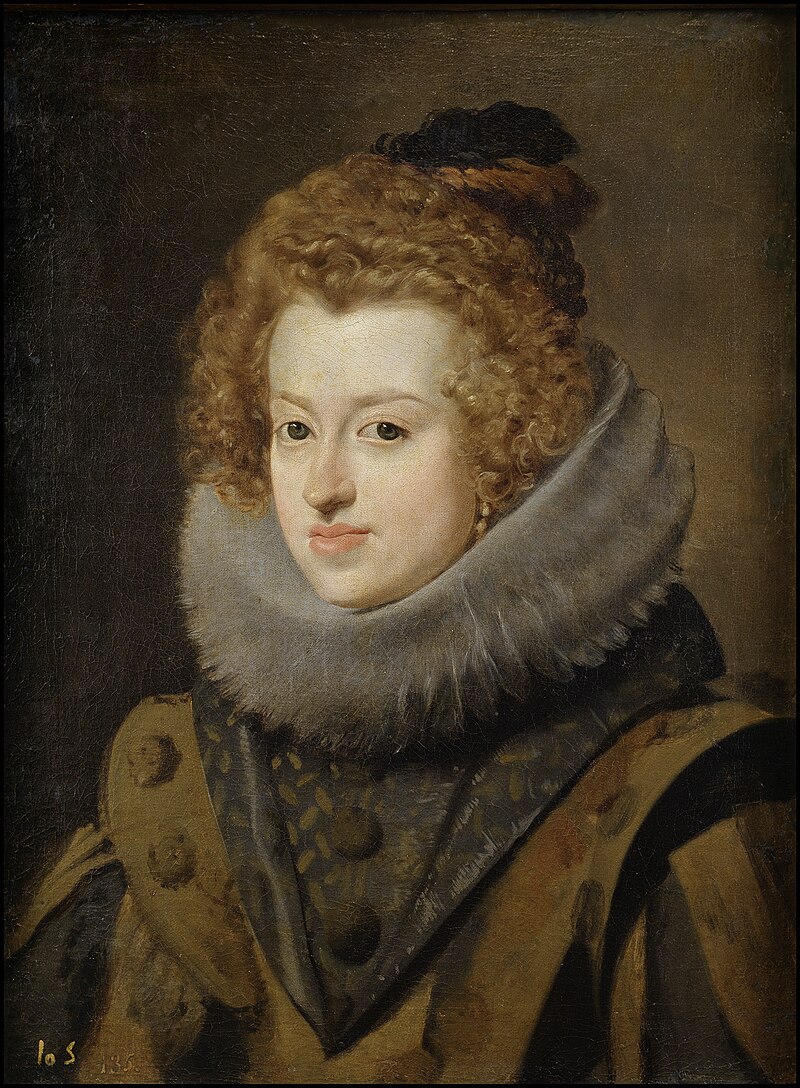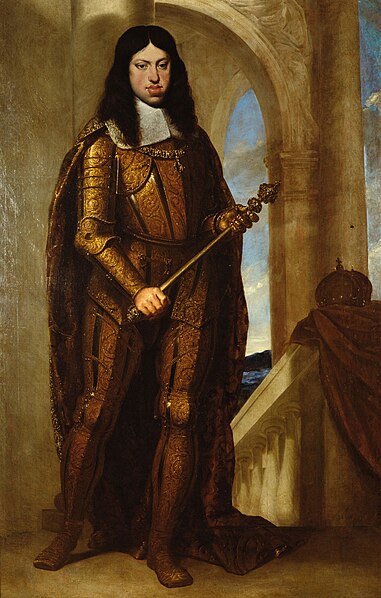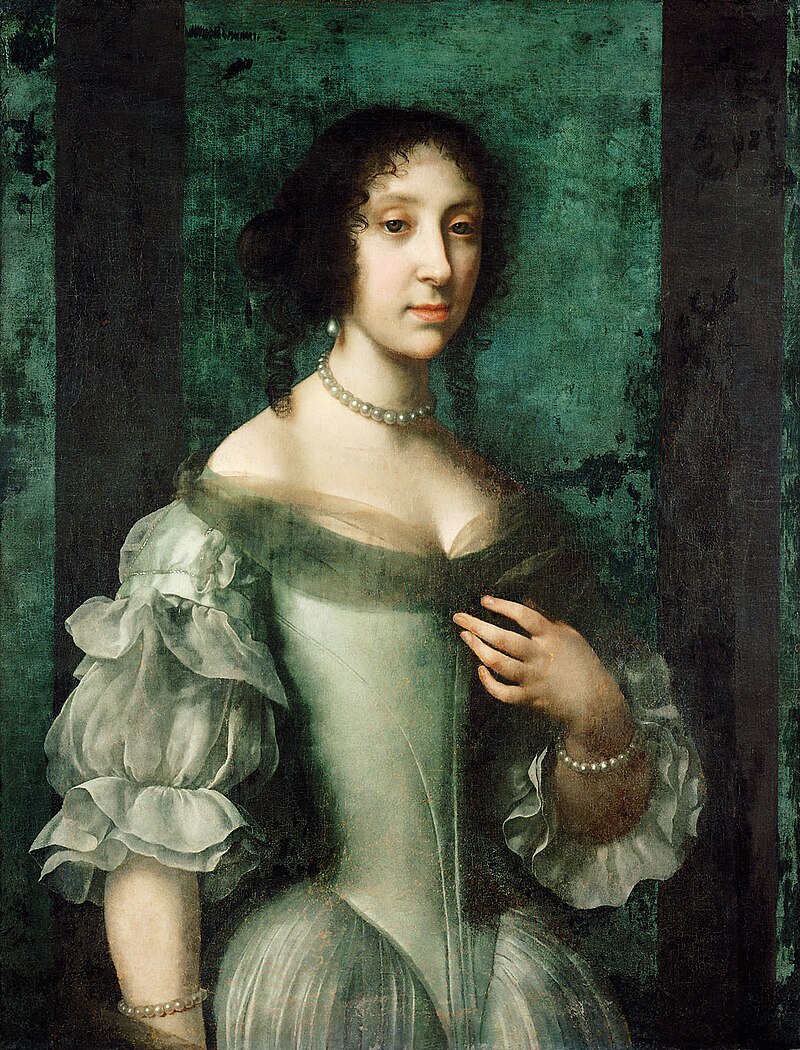by Susan Flantzer
© Unofficial Royalty 2023

Margarita Teresa of Spain, Holy Roman Empress; Credit – Wikipedia
Margarita Teresa of Spain was the first of the three wives of her uncle and first cousin Leopold I, Holy Roman Emperor, King of Hungary, King of Bohemia, Archduke of Austria, King of Croatia, Duke of Teschen, King of the Romans, Archduke of Further Austria, and Prince of Transylvania. Born on July 12, 1651, at the Royal Alcazar in Madrid, Spain, Margarita Teresa was the eldest of the five children and the elder of the two daughters of Felipe IV, King of Spain and his second wife Mariana of Austria, who were uncle and niece, an example of inbreeding. Margarita Teresa’s paternal grandparents were Felipe III, King of Spain and Margarete of Austria, who were both children of parents who were an uncle and his niece, and were first cousins once removed and second cousins. Her maternal grandparents were Ferdinand III, Holy Roman Emperor and his first wife Maria Anna of Spain who were first cousins.
Margarita Teresa had four siblings but only one survived childhood:
- Maria Ambrosia de la Concepción of Austria, Infanta of Spain (born and died 1655), died in infancy
- Felipe Prospero of Austria, Prince of Asturias (1657 – 1661), died in childhood, suffered from epilepsy, and was frequently ill, probably due to the generations of inbreeding
- Fernando of Austria, Infante of Spain (1658 – 1659), died in infancy
- Carlos II, King of Spain (1661 – 1700) married (1) Marie Louise d’Orléans, no children (2) Maria Anna of Neuburg, no children
Margarita Teresa had eight half-siblings from her father’s first marriage to Elisabeth of France who died in 1644, at the age of forty-one, after miscarrying a son. Only one half-sister survived to adulthood, Maria Theresa who married King Louis XIV of France.
- Maria Margarita of Austria, Infanta of Spain (born and died 1621)
- Margarita Maria Catalina of Austria, Infanta of Spain (born and died 1623)
- Maria Eugenia of Austria, Infanta of Spain (1625 – 1627)
- Isabella Maria of Austria, Infanta of Spain (born and died 1627)
- Balthasar Carlos of Austria, Infante of Spain, Prince of Asturias (1629 – 1646), died at age 16 from smallpox
- Francisco Fernando of Austria, Infante of Spain (born and died 1634)
- Maria Ana Antonia of Austria, Infanta of Spain (born and died 1636)
- Maria Theresa of Austria, Infanta of Spain (1638 – 1683), married King Louis XIV of France, had six children but only one son survived childhood

Las Meninas (Spanish for ‘The Ladies-in-Waiting), 1656 by Diego Velázquez – Five-year-old Margarita Teresa is surrounded by her entourage of maids of honor, a chaperone, a bodyguard, two dwarfs, and a dog in a room in the Royal Alcazar of Madrid; Credit – Wikipedia
Margarita Teresa was raised in the chambers of her mother Margarete of Austria at the Royal Alcazar in Madrid, surrounded by numerous ladies-in-waiting and servants. Brought up with the strict etiquette of the Spanish court, she received an excellent education.
The House of Habsburg, which then ruled in Spain, Holy Roman Empire, and the various hereditary Habsburg lands, was notorious for its inbreeding. The Habsburgs had built their empire by marriage and they wanted to keep the land they amassed all in the family, so they began to intermarry more and more frequently among themselves. Seven of Margarita Teresa’s eight great-grandparents were descended from Juana I, Queen of Castile and León and Aragon and her husband Philip of Habsburg, Duke of Burgundy. While a person in the fifth generation normally has thirty-two different ancestors, Margarita Teresa had only ten different ancestors in the fifth generation.

King Carlos II of Spain, Margarita Teresa’s brother who had serious health issues and disabilities due to inbreeding; Credit – Wikipedia
Although Margarita did not develop the serious health issues and disabilities that her younger brother King Carlos II of Spain had shown since his birth (she did have the Habsburg jaw as did her husband Leopold), the inbreeding could have been a cause of the early deaths of three of her four children and the three children of her only surviving child. Margarita’s brother Carlos was a weak, sick child from birth. He did not learn to talk until he was four years old and could not walk until he was eight years old. Like many of the Habsburg family, Carlos had the Habsburg jaw (mandibular prognathism), a disfiguring genetic disorder in which the lower jaw outgrows the upper jaw. However, Carlos’ very pronounced Habsburg jaw was so severe that he swallowed his food without thoroughly chewing. Carlos’ condition showed clear signs of the long-time inbreeding of the House of Habsburg.

Margarita Teresa’s husband Leopold I, Holy Roman Emperor; Credit – Wikipedia
On April 6, 1663, twelve-year-old Margarita Teresa was betrothed to her 23-year-old uncle and first cousin Leopold I, Holy Roman Emperor, the son of Ferdinand III, Holy Roman Emperor and the first of his three wives who was also his first cousin Maria Anna of Austria. It was felt that Leopold and Margarita Teresa’s marriage between the Spanish and Austrian branches of the House of Habsburg was needed to strengthen the position of both countries, especially against the Kingdom of France. The marriage between Leopold and Margarita Teresa was delayed because of the age of the bride. The couple was married by proxy in Madrid, Spain on April 25, 1666, with the groom represented by Antonio de la Cerda, 7th Duke of Medinaceli.
Three days later, Margarita Teresa began her journey, via ship and then over land, from Madrid to Vienna. At each stop, where Margarita Teresa spent time resting, there were celebrations in her honor. On November 25, 1666, in Schottwien, twelve miles from Vienna, Holy Roman Emperor Leopold I came to receive his bride. Margarita Teresa formally entered Vienna on December 5, 1666, and 26-year-old Leopold and 15-year-old Margarita, first cousins, uncle and niece, were married seven days later. Despite the age difference, the couple had a happy marriage. Margarita Teresa always called her husband “Onkel”, German for uncle, and Leopold called her “Gretl”, a German diminutive of Margarita. Margarita Teresa and Leopold had many common interests, especially in art and music.

Margarita Teresa and her only surviving child Maria Antonia; Credit – Wikipedia
Margarita Teresa and Leopold had four children but only one survived to adulthood:
- Archduke Ferdinand Wenzel of Austria (1667 – 1668), died in infancy
- Archduchess Maria Antonia of Austria (1669 – 1692), married Maximilian II Emanuel, Elector of Bavaria, had three sons, none survived childhood
- Archduke Johann Leopold of Austria (born and died 1670), died on the day of his birth
- Archduchess Maria Anna Antonia of Austria (born and died 1672), died fourteen days after her birth
Margarita Teresa was very religious and was the driving force behind Leopold’s expulsion of the Jews from Vienna in 1670. She blamed the Jews for her two miscarriages, the early deaths of her two sons, and the fire in the newly built Leopoldine wing of the Hofburg Palace. During her marriage, Margarita Teresa kept her Spanish customs, was surrounded almost exclusively by her Spanish retinue, and hardly learned the German language. Due to the aloofness and arrogance of the Spanish retinue, an anti-Spanish mood spread at court, which also turned against Margarita Teresa. The courtiers unashamedly expressed their hope that Margarita Teresa, who was often ill, would soon die so that Leopold could marry someone more acceptable to them.
Tomb of Margarita Teresa; Credit – Von krischnig – selbst fotografiert, Bild-frei, https://de.wikipedia.org/w/index.php?curid=3431689
Weakened from six pregnancies in six years (four living childbirths and two miscarriages), and four months into her seventh pregnancy, Margarita Teresa died at the Hofburg Palace in Vienna, then in the Archduchy of Austria, on March 12, 1673, at the age of 21, and was buried in the Imperial Crypt at the Capuchin Church in Vienna. Despite his grief and because he had no male heir, several months later, Leopold married Archduchess Claudia Felicitas of Austria, from the Tyrol branch of the House of Habsburg. After giving birth to two daughters who did not survive infancy, Claudia Felicitas died from tuberculosis three years after her marriage. Leopold’s third wife Eleonore Magdalene of Neuberg finally provided him with male heirs, two sons who both became Holy Roman Emperors.
This article is the intellectual property of Unofficial Royalty and is NOT TO BE COPIED, EDITED, OR POSTED IN ANY FORM ON ANOTHER WEBSITE under any circumstances. It is permissible to use a link that directs to Unofficial Royalty.
Works Cited
- Flantzer, Susan. (2022) Felipe IV, King of Spain, Filipe III, King of Portugal, Unofficial Royalty. Available at: https://www.unofficialroyalty.com/felipe-iv-king-of-spain-filip-iii-king-of-portugal/ (Accessed: 10 July 2023).
- Flantzer, Susan. (2023) Leopold I, Holy Roman Emperor, Unofficial Royalty. Available at: https://www.unofficialroyalty.com/leopold-i-holy-roman-emperor-king-of-hungary-king-of-bohemia-archduke-of-austria-king-of-croatia-duke-of-teschen-king-of-the-romans-archduke-of-further-austria-and-prince-of-transylv/ (Accessed: 10 July 2023).
- Margaret Theresa of Spain (2023) Wikipedia. Available at: https://en.wikipedia.org/wiki/Margaret_Theresa_of_Spain (Accessed: 10 July 2023).
- Margarita Theresa von Spanien (2023) Wikipedia. Available at: https://de.wikipedia.org/wiki/Margarita_Theresa_von_Spanien (Accessed: 10 July 2023).
- Wheatcroft, Andrew. (1995) The Habsburgs. London: Viking.
- Wilson, Peter H. (2016) Heart of Europe – A History of the Holy Roman Empire. Cambridge, MA: Harvard University Press.



































